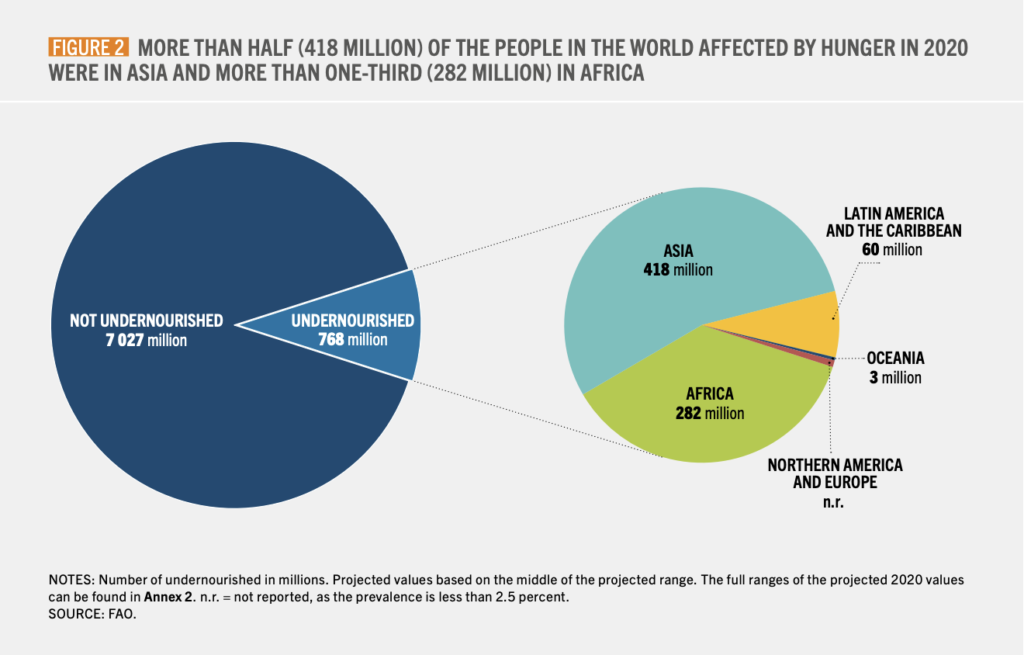Blog by Liliana Mosca, SI United Nations Representative, Rome.
In July 2021, the Food and Agriculture Organisation (FAO) published its annual report titled “State of Food Security and Nutrition in the World 2021 Report: Transforming Food Systems for Food Security, Improved Nutrition, and Affordable Healthy Diets for All.” The present edition is a clear reflection of the fact that the world has recognised that agri-food systems – and their transformation – are central to building forward better after COVID-19, and to achieving the Sustainable Development Goals (SDGs).
The report was jointly produced by the UN Food and Agriculture Organisation (FAO), the International Fund for Agricultural Development (IFAD), the UN Children’s Fund (UNICEF), the World Food Programme (WFP) and the World Health Organisation (WHO).
The Report provides an eloquent indication of the impact of COVID-19 pandemic on food security – stated by the heads of the five UN agencies in the Foreword as well of four major drivers: economic slowdowns and downturns; climate variability and extremes; conflict and cost; and affordability of healthy diets. In addition to the four drivers, the Report revealed that hunger has increased where there is a high inequality.
The Report also attested that:
- Global hunger increased under the shadow of the COVID-19 pandemic: in fact, between 720 and 811 million people in the world faced hunger in 2020 – as many as 161 million more than in 2019. Hunger increased in all regions of the world from 2019 to 2020: 418 million in Asia, 282 million in Africa and 60 million in Latin America and the Caribbean.
- The pandemic heightened the challenge of eradicating hunger: more than 650 million may still be facing hunger in 2030, including tens of millions linked to possible lasting effects of the pandemic.
- Nearly 2.4 billion people in the world lacked access to adequate food in 2020: the increase in moderate or severe food insecurity in 2020 equalled that of the previous five years combined.
- Healthy diets are out of reach for around 3 billion people: the increased cost of healthy diets and high levels of income inequality put healthy diets further out of reach in Africa and in Latin America and the Caribbean.
- The world is not on track to achieve global nutrition targets: some progress has been made, but the effects of the pandemic on nutrition will cause setbacks.

Image from the State of Food Security and Nutrition in the World 2021 Report.
The State of Food Security and Nutrition in the World estimates that SDG 2 (Zero Hunger by 2030) will be missed by a margin of nearly 660 million people.
The report identifies six “transformation pathways”, that, the authors say, rely on a “coherent set of policy and investment portfolios” to end hunger and malnutrition in all its forms:
- Integrating humanitarian, development and peacebuilding policies in conflict areas.
- Scaling up climate resilience across food systems.
- Strengthening the resilience of the most vulnerable to economic adversity.
- Intervening along supply chains to lower the cost of nutritious foods.
- Tackling poverty and structural inequalities ensuring interventions are pro poor and inclusive.
- Strengthening food environments and changing consumer behaviour to promote dietary patterns with positive impacts on human health and the environment.
In conclusion the Report encourages policymakers to consult, empower women and young people and to expanding the availability of data and new technologies, but above all, it urges the world to act now – or the drivers of hunger and malnutrition will persist in coming years.
Read the full report HERE.

